Jeffrey Tucker: The Fed Fears Something Worse Than a Bear Market
Commentary
The strategy of buying the dip went on for months, with unrelenting hope that this was all surely temporary. The economy was opening. Congress was spending. The Fed surely would not crash the markets before the November election. All will be well. No reason to panic. Not even weekly warning by the Fed would convince a generation of traders who have only known bull markets that times have really changed.
Part of the illusion traces to two years ago when the unthinkable happened. Governments all over the world locked down people and trade. Sure, markets suffered a bit but then the financials came roaring back. All this happened despite the Biden administration’s unfriendly view toward growth, its intensification of regulations, and its uncomprehending schemes imposed on sector after sector.
Still, financials somehow pushed through. The smart money knew that stocking up would always win in the long run. Not even the ever louder threats from the Fed to take away the punch bowl could dent the psychology that ever-higher earnings were baked into the financial firmament. Even once inflation kicked into high gear, market psychology lived in the hope that stocks still outrun currency depreciation.
Then yesterday happened.
Financials finally crossed the line into an official bear market. The Fed surely knew this would happen with its march to ever higher rates, which are still not high enough to outrun the inflation that the Fed itself unleashed in its arrogant presumption that it could costlessly paper over the worst economic policies in the history of humanity. But as Daniel Lacalle writes, “Markets and politicians are so accustomed to easy money that even the slightest normalization causes havoc around the world.”
Again, the Fed has a very long way to go to tame the inflationary beast, which might portend a very cold winter on Wall Street. Goldman Sachs has joined many other smaller firms in laying off workers to cut costs while predicting some grave future of suffering. The liquidity sloshing around the world today is still seeking a home in ways that are unpredictable, leaving one sector only to visit itself on another in the form of inflation. Labor markets have never been this broken in the postwar period, which seriously impacts the prospects for economic growth.
What might the Fed have seen that others missed? Why the sudden turnaround from writing endless unbounceable checks to cover Congress’s spending manias to suddenly embracing some monetary sanity? It’s possible that they truly worried about something unthinkable like a genuine crackup boom that would rival the interwar experience of Germany.
For well over 100 years, monetary managers have defaulted to what’s called the quantity theory of money, summed up in the formula MV=PQ. In this view, money quantity is conditioned on the pace at which it is spent (velocity) will in the long run equal the price level conditioned on economic output, or real GDP. Presuming that the Fed can control money’s quantity (a big assumption), it cannot control its velocity. That is subject to patterns of spending and investing emanating from the choices of market participants themselves. Still, velocity tends to be stable over the long run. A “good” central bank policy would reveal a pattern where prices, monetary expansion, and velocity are stable with no shocking changes among any of the variables.
After the lockdowns of March 2020, money velocity took a plunge that has no precedent in postwar history. It crashed down 25 percent. This was due to extreme fear and sudden risk aversion. Only a few months later, the money supply itself (defined by M2) exploded at an unprecedented rate of 26 percent. Another 12 months went by and inflation started taking off. What they hoped would be transitory turned into a major problem.
But here is the key. During the whole of 2021 and extending all the way to the start of this year, the velocity of money stayed extremely low. This in normal times would be a blessing because a low velocity would normally mitigate against the upward price pressure coming from dramatic monetary expansion. In this case, inflation took off despite historically low velocity.
If you are a central banker watching the charts, what message do you get from this? You deduce that you are sitting on a powder keg that could result in a genuine disaster for the history books. All it would take to change that V in the equation would be a shift in inflationary psychology. This happens when people expect a much higher rate of inflation in the future and start treating paper like poison, something to get rid of rather than to hold. The V in the equation could reverse. Then you have on your hands a mega problem without a solution.
Here is an example of what the Fed was seeing when it started its campaign to reverse course. Stability turned to instability. Prices started soaring even without a reversal in money velocity. Once velocity started turning northward, panic ensued. The Fed ignored the propaganda from the White House that everything was fine and embarked upon a major campaign to tighten money, even risking a near-certain recession and housing-market crash.
Pulling back to 1948 for a bit of context, we can see that there is no postwar precedent for the crazy numbers we are seeing now. We’ve never seen money velocity shift this far this fast, money supply increase this far this fast, and prices respond so dramatically upward with such low velocity.

A bear market is not what the Fed wanted but it is what the Fed is willing to tolerate in order to avoid a much-worse fate that they feared could in fact happen over the next year or two. Being behind the controls of the money machine during the worst inflation since the American Revolution is certainly not how one wants history to describe one’s career. So they decided to act, even risking the ire of the party in power.
Now, you can look at this model and these charts and say that all of this is too simple, too clean, too presumptive of the Fed’s power and intentions. This critique is exactly right. But here’s the problem. The Fed today is dealing with a situation without any precedent in history. The lie that they came to believe following 2008—that the Fed could feed the beast forever with no real consequence—came crashing down, leaving the masters of money with no real model. So they defaulted back to a century-old formula.
Benjamin Anderson was an economist from the same period in which the quantity theory was invented (1910s) and he wrote a major assault on the theory in his book “The Value of Money.” His point is that nearly every assumption in the theory relied on assumptions that are simply not true. Money never enters the economy in neutral ways. Velocity is not stable and probably not measurable. For that matter, there is no such thing as a price level that rises and falls like the sea level.
Markets are far too complex to be mathematicized in such simple ways, he wrote. The best a central banker can do is preserve the core soundness of money itself, never bowing to the winds of politics or the exigencies of financial conditions. His view was proven correct, as the Fed botched both the 1920s and the response to the market crash of 1929 and following.
The real problem is not the Fed’s current actions. The egregious errors trace to 2020, when the Fed decided to become the financial benefactor of lockdown policies, thereby giving the bureaucrats and politicians the gift of a lifetime. The Fed protected the worst and stupidest people and institutions in America against the consequences of their own screwups. They did this because they were convinced from experience in 2008 that there would not be a downside.
In fact, it was a disaster. The Fed bears major blame for the continuation of lockdown policies. Congress is not off the hook either. Like the recession, the bear market is nothing but a consequence of man-made policy that was easily preventable. We could have responded to the pathogen like mature adults rather than with a complete freakout that smashed freedom and prosperity. And the Fed could have stood aside and watched rather than joining in the craze by flooding the world with funny money.
Everything about this disaster was created in the laboratories of scientists gone mad, economists and central bankers among them.
Views expressed in this article are the opinions of the author and do not necessarily reflect the views of The Epoch Times.
" Conservative News Daily does not always share or support the views and opinions expressed here; they are just those of the writer."






